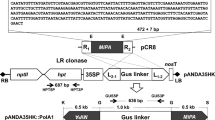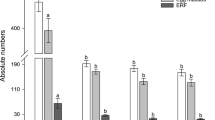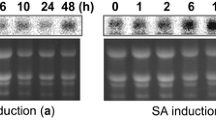Abstract
Plant-parasitic nematodes are a major pest of many plant species and cause global economic loss. A phytocystatin gene, Colocasia esculenta cysteine proteinase inhibitor (CeCPI), isolated from a local taro Kaosiang No. 1, and driven by a CaMV35S promoter was delivered into CLN2468D, a heat-tolerant cultivar of tomato (Solanum lycopersicum). When infected with Meloidogyne incognita, one of root-knot nematode (RKN) species, transgenic T1 lines overexpressing CeCPI suppressed gall formation as evidenced by a pronounced reduction in gall numbers. In comparison with wild-type plants, a much lower proportion of female nematodes without growth retardation was observed in transgenic plants. A decrease of RKN egg mass in transgenic plants indicated seriously impaired fecundity. Overexpression of CeCPI in transgenic tomato has inhibitory functions not only in the early RKN infection stage but also in the production of offspring, which may result from intervention in sex determination.





Similar content being viewed by others
References
Abad P, Favery B, Rosso M-N, Castagnone-Sereno P (2003) Root-knot nematode parasitism and host response: molecular basis of a sophisticated interaction. Mol Plant Pathol 4:217–224
Atkinson HJ, Urwin PE, Clarke MC, McPherson MJ (1996) Image analysis of the growth of Globodera pallida and Meloidogyne incognita on transgenic tomato roots expressing cystatins. J Nematol 28:209–215
Atkinson HJ, Johnston KA, Robbins M (2004) Prima facie evidence that a phytocystatin for transgenic plant resistance to nematodes is not a toxic risk in the human diet. J Nutr 134:431–434
Bird DM, Kaloshian I (2003) Are roots special? Nematodes have their say. Physiol Mol Plant Pathol 62:115–123
Cai D, Thurau T, Tian Y, Lange T, Yeh K-W, Jung C (2003) Sporamin-mediated resistance to beet cyst nematodes (Heterodera schachtii Schm.) is dependent on trypsin inhibitory activity in sugar beet (Beta vulgaris L.) hairy roots. Plant Mol Biol 51:839–849
Castagnone-Sereno P (2006) Genetic variability and adaptive evolution in parthenogenetic root-knot nematodes. Heredity 96:282–289
Castagnone-Sereno P, Bongiovanni M, Dalmasso A (1992) Differential expression of root-knot nematode resistance genes in tomato and pepper: evidence with Meloidogyne incognita virulent and avirulent near-isogenic lineages. Ann Appl Biol 120:487–492
Chan YL, Prasad V, Sanjaya, Chen KH, Liu PC, Chan MT, Cheng CP (2005) Transgenic tomato expressing an Arabidopsis thionin (Thi2.1) driven by fruit-inactive promoter battles against phytopathogenic attack. Planta 221:386–393
Chen J-T, Hanson PM, Kuo CG, Opeña RT (2003) Genetic improvement of summer fresh market tomatoes. J Agric Assoc China 4:83–102
Ehwaeti ME, Elliott MJ, McNicol JM, Phillips MS, Trudgill DL (2000) Modelling nematode population growth and damage. Crop Prot 19:739–745
El-Alfy AT, Schlenk D (2002) Effect of 17{beta}-estradiol and testosterone on the expression of flavin-containing monooxygenase and the toxicity of aldicarb to Japanese Medaka, Oryzias latipes. Toxicol Sci 68:381–388
Fuller VL, Lilley CJ, Urwin PE (2008) Nematode resistance. New Phytol 180:27–44
Hepher A, Atkinson HJ (1992) Nematode control with proteinase inhibitors. European Patent Application Number, 92301890.7. Publication Number 0 502 730 A1
Knapp JE, Chandlee JM (1996) Rapid, small-scale, dual isolation of RNA and DNA from a single sample of orchid tissue. Biotechniques 21:54–56
Koritsas VM, Atkinson HJ (1994) Proteinases of females of the phytoparasite Globodera pallida (potato cyst nematode). Parasitology 109:357–365
Lilley CJ, Urwin PE, Johnston KA, Atkinson HJ (2004) Preferential expression of a plant cystatin at nematode feeding sites confers resistance to Meloidogyne incognita and Globodera pallida. Plant Biotechnol J 2:3–12
Milligan SB, Bodeau J, Yaghoobi J, Kaloshian I, Zabel P, Williamson VM (1998) The root knot nematode resistance gene Mi from tomato is a member of the leucine zipper, nucleotide binding, leucine-rich repeat family of plant genes. Plant Cell 10:1307–1320
Neveu C, Abad P, Castagnone-Sereno P (2003) Molecular cloning and characterization of an intestinal cathepsin L protease from the plant-parasitic nematode Meloidogyne incognita. Physiol Mol Plant Pathol 63:159–165
Omuega CO, Thomason IJ, Roberts PA (1988) A non-destructive technique for screening bean germ plasm for resistance to Meloidogyne incognita. Plant Dis 72:970–972
Rashed NA, MacDonald MH, Matthews BF (2008) Protease inhibitor expression in soybean roots exhibiting susceptible and resistant interactions with soybean cyst nematode. J Nematol 40:138–146
Richardson M (1991) Seed storage proteins: the enzyme inhibitors. Methods Plant Biochem 5:259–305
Rodis P, Hoff JE (1984) Naturally occurring protein crystals in the potato: inhibitor of papain, chymopapain, and ficin. Plant Physiol 74:907–911
Rosskopf EN, Chellemi DO, Kokalis-Burelle N, Church GT (2005) Alternatives to methyl bromide: a Florida perspective. APSnet Feature, June 2005. http://www.apsnet.org/online/feature/methylbromide/
Shingles J, Lilley CJ, Atkinson HJ, Urwin PE (2007) Meloidogyne incognita: molecular and biochemical characterization of a cathepsin L cysteine proteinase and the effect on parasitism following RNAi. Exp Parasitol 115:114–120
Triantaphyllou A (1973) Environmental sex differentiation of nematodes in relation to pest management. Annu Rev Phytopathol 11:4441–4462
Turrà D, Bellin D, Lorito M, Gebhardt C (2009) Genotype-dependent expression of specific members of potato protease inhibitor gene families in different tissues and in response to wounding and nematode infection. J Plant Physiol 166:762–774
Urwin PE, Atkinson HJ, Waller DA, McPherson MJ (1995) Engineered oryzacystatin-I expressed in transgenic hairy roots confers resistance to Globodera pallida. Plant J 8:121–131
Urwin PE, Lilley CJ, McPherson MJ, Atkinson HJ (1997) Resistance to both cyst and root-knot nematodes conferred by transgenic Arabidopsis expressing a modified plant cystatin. Plant J 12:455–461
Walker AJ, Ford L, Majerus MEN, Geoghegan IE, Birch ANE, Gatehouse JA, Gatehouse AMR (1998) Characterisation of the midgut digestive proteinase activity of the two-spot ladybird (Adalia bipunctata L.) and its sensitivity to proteinase inhibitors. Insect Biochem Mol Biol 28:173–180
Wang K-H, McSorley R (2008) Exposure time to lethal temperatures for Meloidogyne incognita suppression and its implication for soil solarization. J Nematol 40:7–12
Wang K-M, Kumar S, Cheng Y-S, Venkatagiri S, Yang A-H, Yeh K-W (2008) Characterization of inhibitory mechanism and antifungal activity between group-1 and group-2 phytocystatins from taro (Colocasia esculenta). FEBS J 275:4980–4989
Williamson VW, Gleason CA (2003) Plant-nematode interactions. Curr Opin Plant Biol 6:327–333
Williamson VM, Hussey RS (1996) Nematode pathogenesis and resistance in plants. Plant Cell 8:1735–1745
Wyss U, Grundler FMW, Munch A (1992) The parasitic behavior of second stage juveniles of Meloidigyne incognita in root of Arabidopsis thaliana. Nematol 38:98–111
Yaghoobi J, Kaloshian I, Wen Y, Williamson VM (1995) Mapping a new nematode resistance locus in Lycopersicon peruvianum. Theor Appl Genet 91:457–464
Yang AH, Yeh KW (2005) Molecular cloning, recombinant gene expression, and antifungal activity of cystatin from taro (Colocasia esculenta cv. Kaosiung no. 1). Planta 221:493–501
Acknowledgments
Kai-Wun Yeh and Ming-Tsair Chan contributed equally to this study. This study belongs to the TW-SOL project (The International Solanaceae Genome Project—Taiwan) and was supported by grants from the National Science and Technology Program for Agricultural Biotechnology [numbers 95AS-6.2.1-ST-a1 (46), 96AS-1.2.1-ST-a2 (13), and 97AS-1.2.1-ST-a3 (13)] to Dr. Kai-Wun Yeh.
Author information
Authors and Affiliations
Corresponding author
Additional information
Communicated by E. Guiderdoni.
Rights and permissions
About this article
Cite this article
Chan, YL., Yang, AH., Chen, JT. et al. Heterologous expression of taro cystatin protects transgenic tomato against Meloidogyne incognita infection by means of interfering sex determination and suppressing gall formation. Plant Cell Rep 29, 231–238 (2010). https://doi.org/10.1007/s00299-009-0815-y
Received:
Revised:
Accepted:
Published:
Issue Date:
DOI: https://doi.org/10.1007/s00299-009-0815-y




